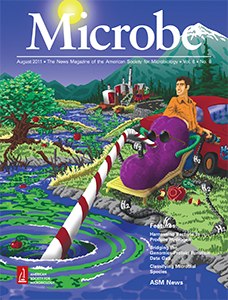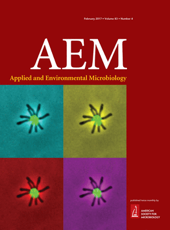
Publications
Publications
Research papers
-
28.Jones-Burrage SE*, TA Kremer*, and JB McKinlay. 2019. Cell aggregation and aerobic respiration are important for Zymomonas mobilis ZM4 survival in an aerobic minimal medium. bioRxiv. doi: https://doi.org/10.1101/526699 * equal contribution.
-
27.Govindaraju A, JB McKinlay, and B LaSarre. 2018. Phototrophic lactate utilization by Rhodopseudomonas palustris is stimulated by co-utilization with additional substrates. bioRxiv. doi: https://doi.org/10.1101/502963
-
26.Schindel HS, JA Karty, JB McKinlay, and CE Bauer. 2018. Characterization of a glycyl-radical enzyme bacterial microcompartment pathway in Rhodobacter capsulatus. J. Bacteriol. DOI: 10.1128/JB.00343-18
Restricted localization of photosynthetic intracytoplasmic membranes in
multiple genera of purple nonsulfur bacteria. mBio. 9: e00780-18
-
24.Lee, FJ, K Miller, JB McKinlay, ILG Newton. 2018. Differential carbohydrate utilization by honey bee core and non-core symbionts. FEMS Microbiol. Ecol. 94: fiy113
-
23.McCully, AL, MG Behringer, JR Gliessman, EV Pilipenko, JL Mazny,
M Lynch, DA Drummond and JB McKinlay. 2018. An Escherichia
coli nitrogen starvation response is important for mutualistic
coexistence with Rhodopseudomonas palustris. Appl. Environ.
Microbiol. 84: e00404-18
-
22.McCully, AL, B LaSarre, and JB McKinlay. 2017. Recipient-biased
competition for an intracellularly generated cross-fed nutrient
is required for coexistence of microbial mutualists. mBio.
-
21.McCully, AL*, B LaSarre*, and JB McKinlay. 2017. Growth-independent cross-feeding modifies
boundaries for coexistence in a bacterial mutualism. Env. Microbiol. 19: 3538-3550
* equal contribution.
-
20.Gliessman, JR, TA Kremer, AA Sangani, SE Jones-Burrage, and JB McKinlay. 2017. Pantothenate auxotrophy in Zymomonas mobilis ZM4 is due to a lack of aspartate decarboxylase activity. FEMS Microbiol. Lett. 364: fnx136 DOI: https://doi.org/10.1093/femsle/fnx136
-
19.Dalia, TN, CA Hayes, S Stolyar, CJ Marx, JB McKinlay, and AB Dalia. 2017. Multiplex genome editing by
natural transformation (MuGENT) for synthetic biology in Vibrio natriegens. ACS Synth. Biol.
DOI: 10.1021/acssynbio.7b00116
-
18. Fritts, RK, B LaSarre, AM Stoner, AL Posto, and JB McKinlay. 2017. A
Rhizobiales-specific unipolar polysaccharide adhesin contributes to
Rhodopseudomonas palustris biofilm formation across diverse
photoheterotrophic conditions. Appl. Environ. Microbiol. 83: e03035-16
-
17.LaSarre, B, AL McCully, JT Lennon, and JB McKinlay. 2017. Microbial
mutualism dynamics governed by dose-dependent toxicity of cross-fed
nutrients. ISME J. 11: 337-348.
-
16.McCully, AL and JB McKinlay. 2016. Disrupting Calvin cycle phosphoribulokinase activity in
Rhodopseudomonas palustris increases the H2 yield and specific production rate proportionately. Int. J.
Hydrogen. Energ. 41: 4143-4149.
-
15.Kremer, TA*, B LaSarre*, AL Posto, and JB McKinlay. 2015. N2 gas is an effective fertilizer for bioethanol production by Zymomonas mobilis. Proc. Natl. Acad. Sci. USA. 112: 2222-2226. * equal contribution. Press
-
14.Gordon, GC and JB McKinlay. 2014. Calvin cycle mutants of photoheterotrophic purple non-sulfur bacteria fail to grow due to an electron imbalance rather than toxic metabolite accumulation. J. Bacteriol. 196:1231-1237.
-
13.McKinlay, JB, Y Oda, M Rühl, AL Posto, U Sauer, and CS Harwood. 2014. Non-growing Rhodopseudomonas palustris increases the hydrogen gas yield from acetate by shifting from the glyoxylate shunt to the tricarboxylic acid cycle. J. Biol. Chem. 289: 1960-1970.
-
12.Adessi, A, JB McKinlay, CS Harwood, and R De Philippis. 2012. A Rhodopseudomonas palustris nifA* mutant produces H2 from NH4+ -containing vegetable wastes. Int. J. Hydrogen. Energ. 37: 15893-15900.
-
11.Jiao, Y, A Navid, B Stewart, JB McKinlay, M Thelen, and J Pett-Ridge. 2012. Syntrophic metabolism of a co-culture containing Clostridium cellulolyticum and Rhodopseudomonas palustris for hydrogen production. Int. J. Hydrogen. Energ. 37: 11719–11726.
-
10.McKinlay, JB and CS Harwood. 2011. Calvin cycle flux, pathway constraints and substrate redox state together determine the H2 biofuel yield in photoheterotrophic bacteria. mBio. 2:doi:10.1128/mBio.00323-10. Press
-
9.McKinlay, JB, M Laivenieks, BD Schindler, AA McKinlay, S Siddaramappa, JF Challacombe, SR Lowry, A Clum, AL Lapidus, KB Burkhart, V Harkins and C Vieille. 2010. A genomic perspective on the potential of Actinobacillus succinogenes for industrial chemical production. BMC Genomics. 11: 680.
-
8.Huang, JJ, EK Heiniger, JB McKinlay, and CS Harwood. 2010. Production of hydrogen gas from light and the inorganic electron donor thiosulfate by Rhodopseudomonas palustris. Appl. Environ. Microbiol. 76: 7717-7722.
-
7.McKinlay, JB and CS Harwood. 2010. Carbon dioxide fixation as a central redox cofactor recycling mechanism in bacteria. Proc. Natl. Acad. Sci. USA. 107: 11669-11675.
-
6.McKinlay, JB and C Vieille. 2008. 13C-metabolic flux analysis of Actinobacillus succinogenes fermentative metabolism at different NaHCO3 and H2 concentrations. Metab. Eng. 10: 55-68.
-
5.McKinlay, JB, Y Shachar-Hill, JG Zeikus, and C Vieille. 2007. Determining Actinobacillus succinogenes metabolic pathways and fluxes by NMR and GC-MS analysis of 13C-labeled metabolic product isotopomers. Metab. Eng. 9: 177-192.
-
4.McKinlay, JB, JG Zeikus, and C Vieille. 2005. Insights into Actinobacillus succinogenes fermentative metabolism in a chemically defined growth medium. Appl. Environ. Microbiol. 71: 6651-6656.
-
3.Master, ER, JB McKinlay, GR Stewart, and WW Mohn. 2005. Biphenyl uptake by psychrotolerant Pseudomonas sp. strain Cam-1 and mesophilic Burkholderia sp. strain LB400. Can. J. Microbiol. 51: 399-404.
-
2.McKinlay, JB, and JG Zeikus. 2004. Extracellular iron reduction is mediated in part by neutral red and hydrogenase in Escherichia coli. Appl. Environ. Microbiol. 70: 3467-3474.
-
1.Kim, P, M Laivenieks, J McKinlay, C Vieille, and JG Zeikus. 2004. Construction of a shuttle vector for the overexpression of recombinant proteins in Actinobacillus succinogenes. Plasmid. 51: 108-115.

Reviews
-
3. McKinlay, JB and CS Harwood. 2011. Harnessing bacteria that use light to produce hydrogen. Microbe. 6: 345-351.
-
2.McKinlay, JB and CS Harwood. 2010. Photobiological production of hydrogen gas as a biofuel. Curr. Opin. Biotechnol. 21: 244-251.
-
1.McKinlay, JB, C Vieille, and JG Zeikus. 2007. Prospects for a bio-based succinate industry. Appl. Microbiol. Biotechnol. 76: 727-740.
Book Chapters
-
2.McKinlay, JB. 2014. Systems biology of photobiological hydrogen production by purple non-sulfur bacteria. In Microbial Bioenergy: Hydrogen Production ed. Edited by D. Zannoni and R. De Philippis. Springer, Dordrecht.
-
1.McKinlay, JB and CS Harwood. 2010. Applications of stress response studies: biofuel production. In
Bacterial Stress Responses 2nd ed. Edited by G. Storz and R. Hengge. ASM Press.
t h e M c K i n l a y L a b
Department of Biology, Indiana University, Bloomington
All webpage artwork copyright Jake McKinlay. Contact for permission to use.



Jake McKinlay 2017
